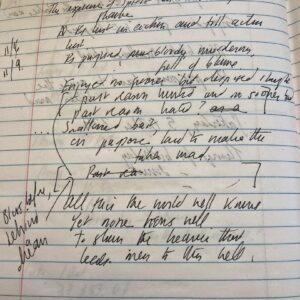Howard Nemerov, far from an absolutist about form, meter, and rhyme, nevertheless preferred to write within certain boundaries of poetic tradition. “I like filling out the old forms,” he’d say with a bemused smile as if referring to his income tax returns, “they keep me from being stupider than the law allows.” Along with contemporaries like Richard Wilbur and Mona Van Duyn, Nemerov was influenced by the New Critics’ valorization of formalist verse. A subsequent generation brought “New Formalists” like Dana Gioia, Marilyn Hacker, and Mark Jarman, a loose poetic movement often attacked by critics wielding a very broad brush. Ira Sadoff, for example, denounced Gioia and others in an essay calling neo-formalism “a dangerous nostalgia” built on white privilege and bourgeois pretension.
Today, while Sadoff and other free verse warriors still dismiss formalist poetry as “the sterile, conservative, aesthete academicism of the nineteen-fifties,” and poets and pundits whose work may well fit Sadoff’s description respond in kind, a diverse and fertile middle ground has emerged between form and freedom, bearing much fruit. “American sonnets,” for example, are fourteen-line poems without metric requirements or rhyme schemes, a hybrid form championed by African-American poets such as the late Wanda Coleman and Terrance Hayes. Other poets fully inhabit old forms when appropriate, as in Marilyn Nelson’s magnificent crown of sonnets in memory of Emmett Till.
Writers have always labored at the intersection of novelty and tradition. Even Ezra Pound’s early twentieth century modernist slogan, “Make it new!” was knowingly borrowed from the founder of the bronze age Shang dynasty, Ch’eng T’ang. St. Augustine likened his affection for and use of classical pagan literature to the Israelites bearing away Egyptian gold. The truth such works contain is no less true for having been written by non-Christians. What one does with it, however, matters immensely. Gold can be refashioned to adorn the tabernacle or made into the image of a calf.
For contemporary poets, there’s more gold to be found in tradition than meter and rhyme. In an era that privileges the lyric, poets have successfully revived neglected poetic genres, as in Derek Walcott’s return to epic with Omeros or in Sydney Lea’s narratives such as “The Feud.” Two recent collections by emerging women poets turn to other, half-forgotten modes: midrash and romance.
Aggadic midrash, the quintessentially Jewish practice of creatively reimagining scriptural narratives to interpret, expand, or interrogate the text, is neither a poetic form nor category. The best midrashim, however, sizzle with poetic intensity as they probe irritant nodes of Scripture that resist ready exegesis: the sacrifice of Isaac, the fate of Lot’s wife, the killing of Jephthah’s daughter. Amy Bornman’s There is a Future: A Year of Daily Midrash (published in 2021 by Paraclete Press), is the debut collection of a young poet whose Evangelical upbringing taught her to read Scripture in search of clear, systematic theological answers. Her tidy interpretive universe crumbled as she took a year to read the Bible through a midrashic lens. In penning her own midrashim, she discovered “a deconstructed and renewed faith,” coming “to understand God less and less but wonder abut God more and more, imagining an extraordinary and spacious gray.”
There is a Future is a record of that imaginative transformation. Her poems, arranged in chronological order accoing to month of composition, are spare, highly personal, and short on literary fireworks, documenting a maturing faith and a growing command of poetic language. Her lines are short, with every word, including “god” and “i,” rendered in lower case, a habit of uncertain utility. Many of the poems are not so much midrashim as intimate reflections on the text. Much of her best work, however, assumes the voice of a character in the biblical narrative or imaginatively enters the scene.
Her poem, “god’s thoughts on blood,” for example, engages the first chapter of Isaiah’s critique of the sacrificial cult. The poem begins:
the red is shocking, isn’t it?
when you cut your skin and it
stains your linen garments, your
floors and wooden tables. i’ve
seen your blood on everything
and i can’t take it anymore.
For me, though, the most moving words in the collection appear in “psalm 45,” written in memory of the late and greatly missed poet and Renaissance scholar, Brett Foster:
i can’t read this psalm, this
my tongue is like the pen of a ready scribe
without seeing your soul like a flame,
flash then snuff, without hearing your
tongue is the pen, rushing to google to read it again,
to see your line breaks like a cairn placed by your hand.
A writer could hardly ask for a better remembrance. If Bornman’s poetry continues to mature, she’ll place some cairns herself, guiding future readers on new journeys.
Lisa Ampleman’s second full length poetry collection, Romances, engages the literature of courtly love, assembling the voices of medieval troubadours, Renaissance poets, and modern-day grunge rockers. Ampleman brings her ironic eye, genuine sensitivity, and a lightly worn cloak of literary scholarship to these pages. The opening poems explicitly invoke the twelfth century French writer, Andreas Capellanus, whose treatise, De Amore (On Love), came to be known as The Art of Courtly Love. De Amore, purporting to instruct a youth named “Walter” in refined manners of romantic love, has been variously read as straightforwardly depicting high medieval courtly mores or as satirizing the nobility’s idle hedonism. What after all should one make of Capellanus’s admonition that “marriage is no real excuse for not loving,” advice Ampleman quotes in “The Rules for Courtly Love (Abridged, Rev. Ed.)”?
Ampleman sustains a blend of warmth and ironic detachment as we’re introduced to women in the lives and work of Dante and Petrarch. We hear, in modern voices, from women poets such as the Renaissance poet Gaspara Stampa and the high medieval trobairitz, counterparts to the male troubadours. The punk heart of this collection, however, is a sequence of American sonnets, “Courtly Love (for Courtney Love),” written to, for, and about the mercurial alt-rock celebrity. We hear from Love in all her moods. In “Setting the Record Straight,” she explains:
You know me as a blond chameleon,
from drug addict to haute couture, but what
the headlines leave out are theology
studies in Ireland (Trinity College),
a novelist grandmother I never met,
my recitation of a poem by Plath
the time I tried to join the Mickey Mouse
Club, and my devotion to the Buddha’s way.
In the concluding sonnet, “Apologia,” the poet speaks:
Dear Courtney, mea culpa, I am sorry
for parroting squawkings and out-and-out lies…
I transcribe and mimeograph you for the sake
of those who’ve loved and lost, or sighed
over a sonnet.
There are many layers in Ampleman’s poems, a richness inviting the reader to listen and ponder. There is, moreover, much more Egyptian gold to be found in the dusty recesses of poetic tradition. I’m grateful for what these two poets have plundered from that vault.
Brian Volck is a pediatrician and writer living in Baltimore. He is the author of a poetry collection, Flesh Becomes Word, and a memoir, Attending Others: A Doctor’s Education in Bodies and Words. His website is Brianvolck.com





